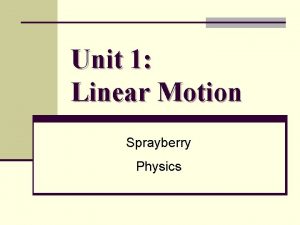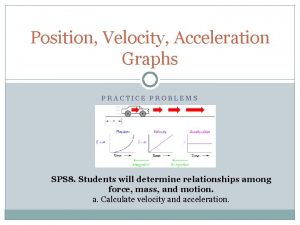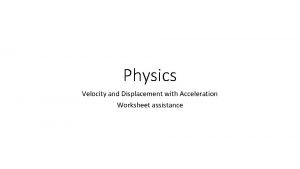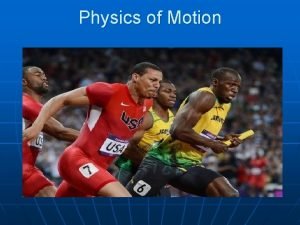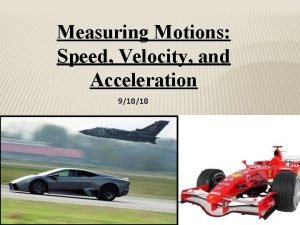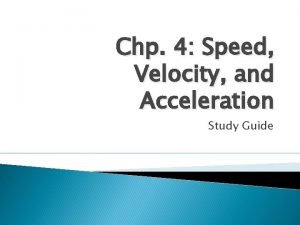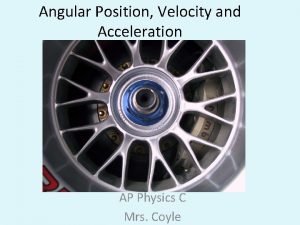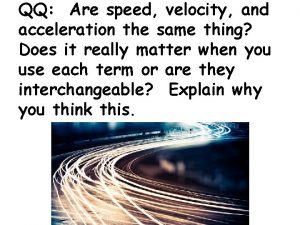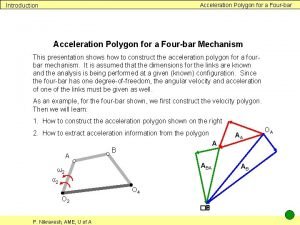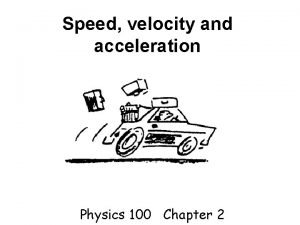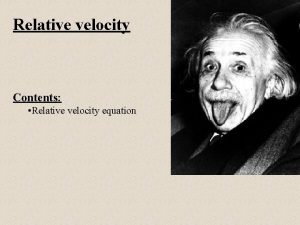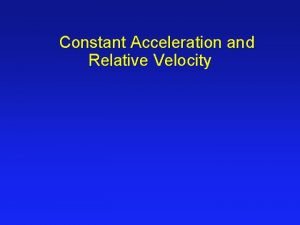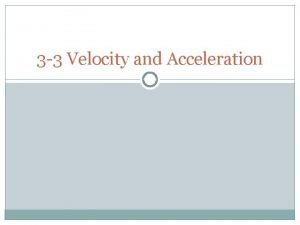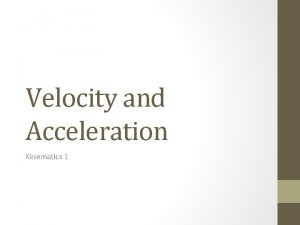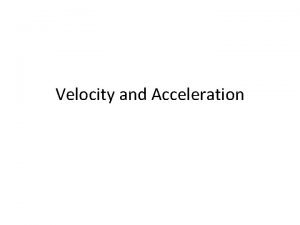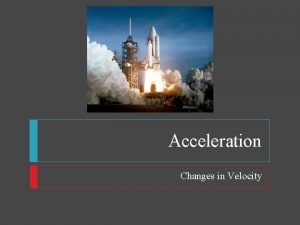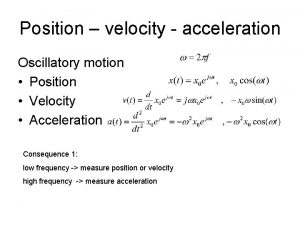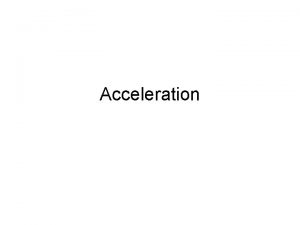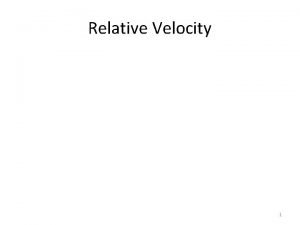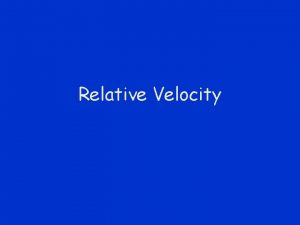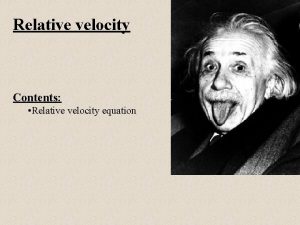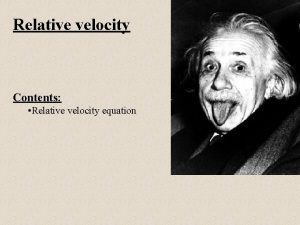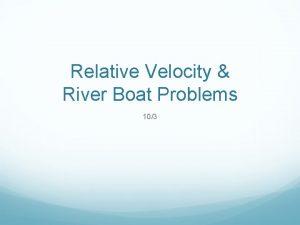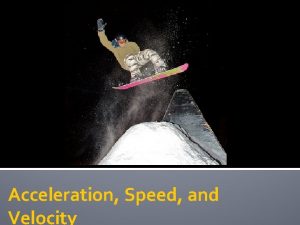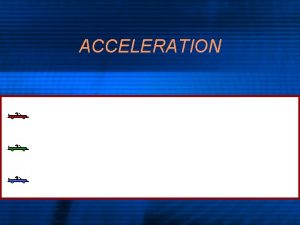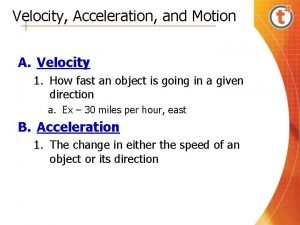RELATIVE VELOCITY AND ACCELERATION IN ONE AND TWO

























- Slides: 25

RELATIVE VELOCITY AND ACCELERATION IN ONE AND TWO DIMENSIONS

RELATIVE VELOCITY �Relative velocity is defined as the velocity of an object B in the rest frame of another object A. �For example: A motorcycle travelling on the highway at a velocity of 120 km/h passes a car travelling at a velocity of 90 km/h.

Representation of relative velocity of two persons w. r. t stationary person

Representation of relative velocity of two cars in reference to x-axis

Can Relative velocity be negative? �Relative velocity can be negative. As relative velocity is the difference between two velocities irrespective of the magnitude of the velocities, it can be negative.

What is difference between velocity and relative velocity? �The difference between velocity and relative velocity is that velocity is measured with respect to a reference point which is relative to a different point. While relative velocity is measured in a frame where an object is either at rest or moving with respect to absolute frame.

What is the need of using relative velocity? �The need for using relative velocity is that it is used for differentiating if the object is at rest or moving.

What is relative velocity formula? �The relative velocity is the velocity that the body A would appear to an observer on the body B and vice versa. � Mathematically, the relative velocity is the vector difference between the velocities of two bodies. �i. e. , Relative velocity = velocity of the body A – velocity of the body B. �The equation is: v. AB = v. A – v. B.

What is the SI unit of relative velocity? �

What is relative velocity example? �We encounter occasions where one or more objects move in a frame which is non-stationary with respect to another observer. �For example, a boat crosses a river that is flowing at some rate or an aeroplane encountering wind during its motion.

When relative velocity is zero? �The relative velocity can be zero. It is absolutely possible because when two bodies move with equal velocity in the same direction, then they have zero relative velocity.

RELATIVE ACCELERATION �Acceleration is the change in an object’s velocity in a specific period of time. �Relative acceleration is the comparison of the acceleration of two bodies or for a rigid body, the acceleration of a point on a rigid body in reference to another point on it.

Formula and Unit for relative acceleration �

RELATIVE VELOCITY AND ACCELERATION IN ONE DIMENSION �Motion does not happen in isolation. �If you’re riding in a train moving at 10 m/s east, this velocity is measured relative to the ground on which you’re traveling. However, if another train passes you at 15 m/s east, your velocity relative to this other train is different from your velocity relative to the ground. �Your velocity relative to the other train is 5 m/s west.

Reference Frames To discuss relative motion in one or more dimensions, we first introduce the concept of reference frames. � When we say an object has a certain velocity, we must state it has a velocity with respect to a given reference frame. � In most examples we have examined this reference frame has been Earth. If you say a person is sitting in a train moving at 10 m/s east, then you imply the person on the train is moving relative to the surface of Earth at this velocity, and Earth is the reference frame. � We can expand our view of the motion of the person on the train and say Earth is spinning in its orbit around the Sun. In this case, the solar system is the reference frame. � In short, all discussion of relative motion must define the reference frames involved. �

Relative Motion in One Dimension �

Cont. . �

Cont. . �

Velocity vectors of the train with respect to Earth, person with respect to the train, and person with respect to Earth.

Relative Velocity in Two Dimensions �

Representation of position of the particle

Cont. . �

Relative velocities �

For number of reference frames �

Relative Acceleration �
 Final velocity initial velocity acceleration time
Final velocity initial velocity acceleration time Deceleration on velocity time graph
Deceleration on velocity time graph Unit of relative velocity
Unit of relative velocity One face one voice one habit and two persons
One face one voice one habit and two persons Angular acceleration vs linear acceleration
Angular acceleration vs linear acceleration Kinetic angular energy
Kinetic angular energy Centripetal acceleration tangential acceleration
Centripetal acceleration tangential acceleration Difference between velocity and acceleration example
Difference between velocity and acceleration example Velocity
Velocity Speed, velocity and acceleration quiz
Speed, velocity and acceleration quiz Speed velocity and acceleration problems answers
Speed velocity and acceleration problems answers What does constant acceleration mean
What does constant acceleration mean Displacement velocity and acceleration worksheet
Displacement velocity and acceleration worksheet Difference between velocity and acceleration
Difference between velocity and acceleration What's the difference between speed and acceleration
What's the difference between speed and acceleration Motion diagram physics
Motion diagram physics Speed velocity and acceleration formulas
Speed velocity and acceleration formulas Speed velocity and acceleration study guide answers
Speed velocity and acceleration study guide answers Angular position velocity and acceleration
Angular position velocity and acceleration Velocity polygon
Velocity polygon Describes both speed and direction
Describes both speed and direction Are speed and acceleration the same thing
Are speed and acceleration the same thing Speed, velocity and acceleration notes
Speed, velocity and acceleration notes Collision forces quick check
Collision forces quick check Velocity polygon
Velocity polygon Velocity and acceleration
Velocity and acceleration







